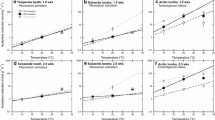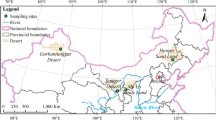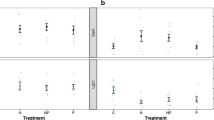Summary
Carbon dioxide exchange rates in excised 2-year-old shoot sections of five common moss species were measured by infrared gas analysis in mosses collected from different stands of mature vegetation near Fairbanks, Alaska. The maximum rates of net photosynthesis ranged from 2.65 mg CO2 g-1h-1 in Polytrichum commune Hedw. to 0.25 in Spagnum nemoreum Scop. Intermediate values were found in Sphagnum subsecundum Nees., Hylocomium splendens (Hedw.) B.S.G., and Pleurozium schreberi (Brid.) Mitt. Dark respiration rates at 15°C ranged from 0.24 mg CO2 g-1h-1 in S. subsecundum to 0.57 mg CO2 g-1h-1 in H. splendens. The dark respiration rates were found to increase in periods of growth or restoration of tissue (i.e., after desiccation). There was a strong decrease in the rates of net photosynthesis during the winter and after long periods of desiccation.
Due to increasing amounts of young, photosynthetically active tissue there was a gradual increase in the rates of net photosynthesis during the season to maximum values in late August. As an apparent result of constant respiration rates and increasing gross photosynthetic rates, the optimum temperature for photosynthesis at light saturation and field capacity increased during the season in all species except Polytrichum, with a corresponding drop in the compensation light intensities. Sphagnum subsecundum seemed to be the most light-dependent species.
Leaf water content was found to be an important limiting factor for photosynthesis in the field. A comparison between sites showed that the maximum rates of net photosynthesis increased with increasing nutrient content in the soil but at the permafrostfree sites photosynthesis was inhibited by frequent moisture stress.
Similar content being viewed by others
References
Bayfield NG (1973) Notes on the water relation of Polytrichum commune. J Bryol 7:607–617
Bazzaz FA, Paolillo DJ, Jagels NN (1970) Photosynthesis and respiration of forest and alpine population of Polytrichum juniperum. Bryologist 73:579–585
Billings WD, Godfrey PJ (1968) Acclimation effects on metabolic rates of arctic and alpine Oxyria populations subjected to temperature stress. Bull Ecol Soc Am 489:68–69
Björkman G, Holmgren P (1963) Adaptability of the photosynthetic apparatus to light intensity in ecotypes from exposed and shaded habitats. Physiol Plant. 16:889–914
Chapin FS III (1974) Morphological and physiological mechanisms of temperature compensation in phosphate absorption along a latitudinal gradient. Ecology 55:1180–1198
Collins NJ, Oechel WC (1974) The pattern of growth and translocation of photosynthesis in a tundra moss, Polytrichum alpinum. Can J Bot 52:355–363
Dahl E, Mork E (1959) Om sambandet mellom temperatur, anding og vekst hos gran (Picea abies (L) Karst.). Medd norske Skogfors Ves 16:81–93 (English summary)
Dixon HN (1954) The student's handbook of British mosses, Eastbourne-London: Sumfield & Day Ltd. p 582
Fraymouth J (1928) The moisture relations of terrestrial algae. Ann Bot 42:75–100
Helmers AE, Todd S, Slaughter CW (1975) Seasonal course of selected climatic parameters. In: Von Cleve K, Dyrness CT (eds), The structure and function of a black spruce (Picea mariana (Mill.) B.S.P.) forest in relation to other fire affected ecosystems. Progress report and research proposal, University of Alaska, p 167–178
Hicklenton P, Oechel WC (1976) Physiological aspects of the ecology of Dicranum fuscescens in the subarctic. I. Acclimation and acclimation potential of CO2 exchange in relation to habitat light and temperature. Can J Bot 1104–1110
Hicklenton P, Oechel WC (1977) The influence of light intensity and temperature on the field carbon dioxide exchange of Dicranum fuscescens in the subarctic. Arctic and Alpine Res 9:407–419
Hoch D (1976) Selected climatic characteristics. Washington Creek experimental area intensive study site. In: Von Cleve K, Dyrness CT (eds). The structure and function of a black spruce (Picea mariana (Mill.) B.S.P.) forest in relation to other fire affected ecosystems. Progress report and research proposal, University of Alaska and U.S. Forest Service
Kallio P, Heinonen S (1975) CO2 exchange and growth of Rhacomitrium lanuginosum and Dicranum elongatum. In: Wielgolaski FE (ed), Fennoscandian tundra ecosystem. Vol I Plants and microorganisms. Springer, Berlin-Heidelberg-New York p 138–148
Levitt J (1956) Hardiness of plants. Academic Press, New York-London p 277
Mustafa J (1978) The effect of growth form and specific variability on photosynthesis along an elevational gradient in the chaparral. M. Sc. thesis. Montreal: McGill University
Oechel WC (1976) Seasonal pattern of temperature response of CO2 flux and acclimation in arctic mosses growing in situ. Photosynthetica 10(4):447–456
Oechel WC, Collins NJ (1976) Comparative CO2 exchange pattern in mosses from two tundra habitats at Barrow, Alaska. Can J Bot 54:1355–1369
Oechel WC, Sveinbjörnsson B (1978) Primary production processes in Arctic bryophytes at Barrow, Alaska. In: Tieszen L (ed), Vegetation and production ecology of an Alaskan artic tundra. Springer, Berlin-Heidelberg-New York, p 269–298
Ogawa T, Shibata K (1965) A sensitive method for determing chlorophyll b in plant extracts. Photochem and Photobiol 4:93–200
Peterson WL, Mayo JM (1975) Moisture stress and its effect on photosynthesis in Dicranum polysetum. Can J Bot 53:2897–2900
Rastorfer JR (1970) Effect on light intensity and temperature on photosynthesis and respiration of two East Antarctic mosses, Bryum argenteum and Bryum antarcticum. Bryologist 73:544–556
Rosswall T, Flower-Ellis JGK, Johannson LG, Ryden BE, Sonesson M (1975) Stordalen (Abisko), Sweden. In Rosswall T, Heal OW (eds), Structure and function of tundra ecosystems Ecol Bull (Stockholm) 20:265–294
Schofield WB (1969) Some common mosses of British Columbia Provincial Museum Handbook No. 28 (Victoria), p 266
Skre O (1975a) CO2 exchange in Norwegian tundra plants studied by infrared gas analyzer technique. In: Wielgolaski FE (ed), Fennoscandian tundra ecosystems Vol. I. Plants and microorganisms Springer, Berlin-Heidelberg-New York, p 168–183
Skre O (1975b) CO2 exchange studies on single species of Norwegian tundra plants during the 1974 season. In: Vik R (ed), Methods and Results, IBP in Norway. Section PT/UM Grazing Project, Hardangervidda, Norwegian National IBP Committee, Oslo, p 297–322
Skre O, Oechel WC (1979) Moss production in a black spruce (Picea mariana (Mill.) B.S.P.) dominated forest with permafrost near Fairbanks, Alaska, as compared with two permafrost-free stands. Hol Ecol 2:249–254
Stålfelt MG (1937) Der Gasaustausch der Moose. Planta 27:30–60
Tamm CO (1953) Growth, yield and nutrition in carpets of a forest moss (Hylocomium splendens). Meddn St Skogforsk Inst 43(1):1–410
Tieszen LL, Johnson DA, Caldwell MM (1974) A portable system for the measurements of photosynthesis using 14-carbon dioxide. Photosynthetica 8(3):151–160
Vitt DH, Andrus RE (1977) The genus Sphagnum in Alberta. Can J Bot 55:331–357
Viereck LA (1975) Forest ecology of the Alaska taiga. Proc. Circumpolar Conf. North. Ecol. Ottawa 1975, p I-1 – I-22
Vowinckel T, Oechel WC, Boll WG (1975) The effect of climate on the photosynthesis of Picea mariana at the subarctic tree line, I. Field measurements. Can J Bot 53:604–620
Weetman G (1968) The relationship between feathermoss growth and the nutrition of black spruce. In: Proceedings of the Third International Peat Conference, p 366–370
Zelitch I (1966) Increased rate of net photosynthetic carbon dioxide uptake caused by the inhibition of glycolate oxidase. Plant Physiol 41:1623–1631
Author information
Authors and Affiliations
Rights and permissions
About this article
Cite this article
Skre, O., Oechel, W.C. Moss functioning in different taiga ecosystems in interior Alaska. Oecologia 48, 50–59 (1981). https://doi.org/10.1007/BF00346987
Received:
Issue Date:
DOI: https://doi.org/10.1007/BF00346987




